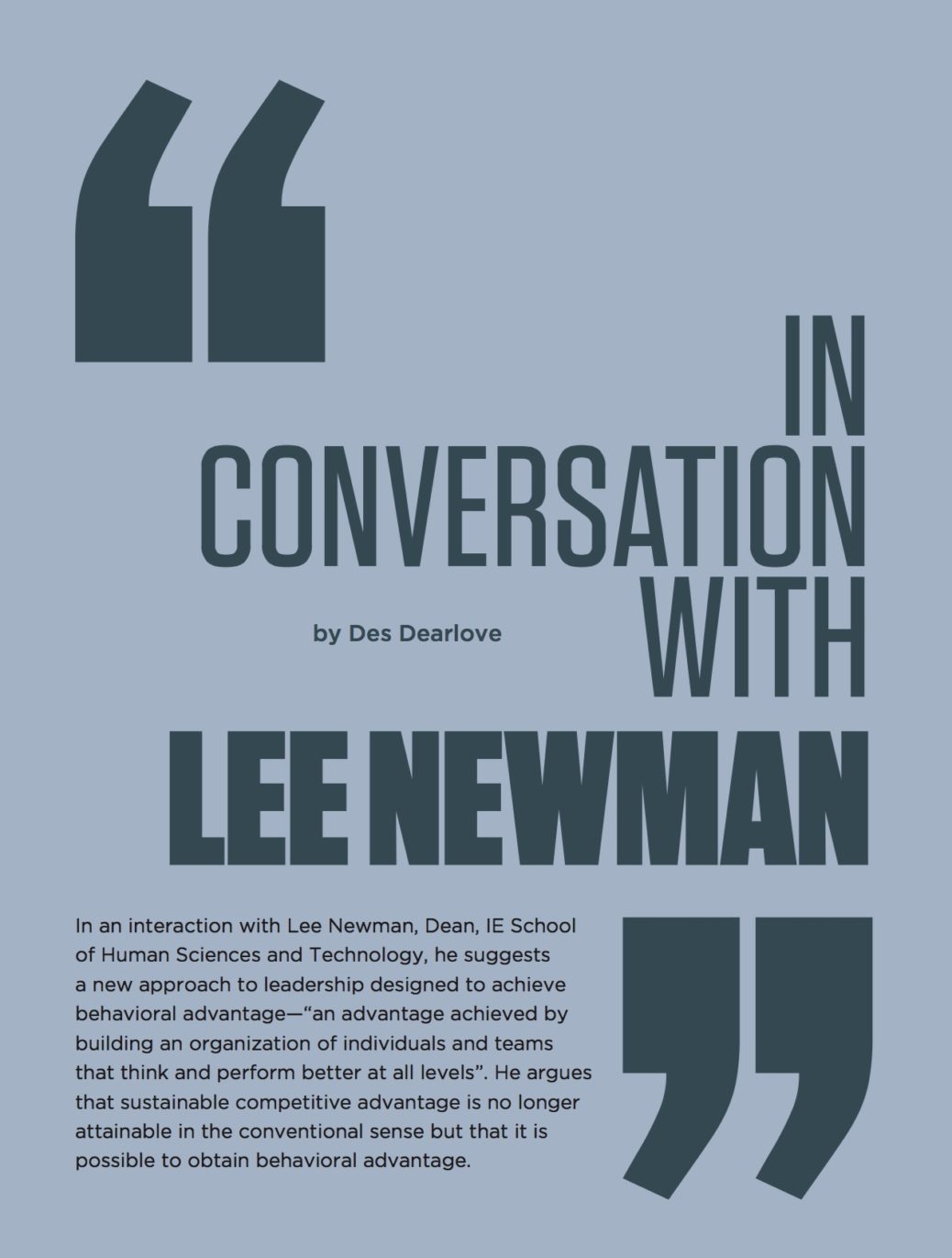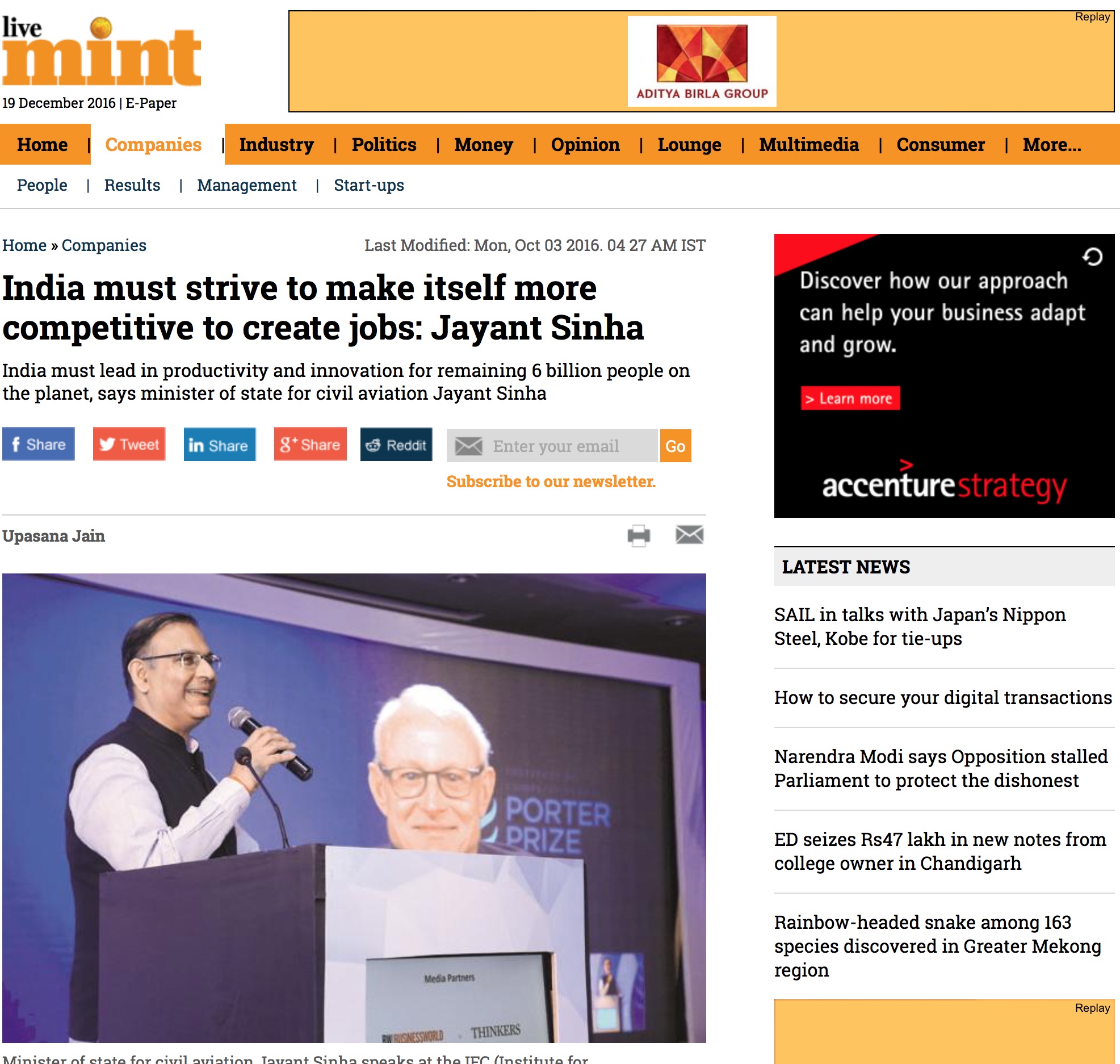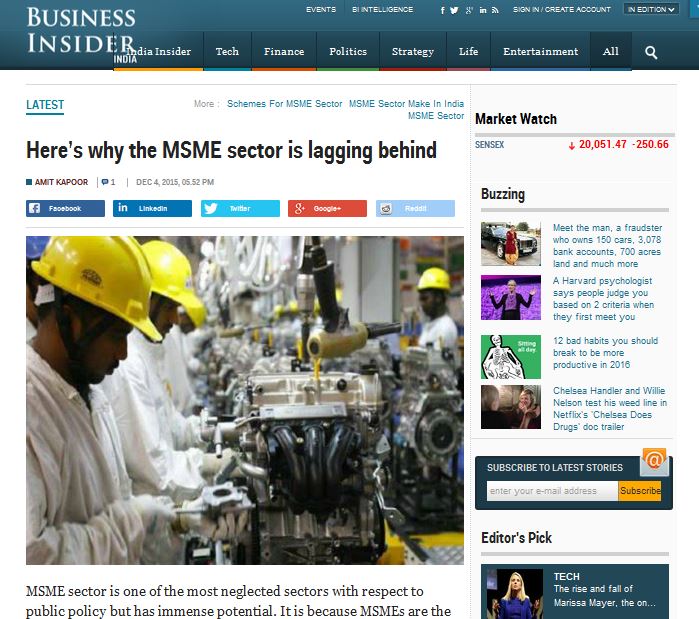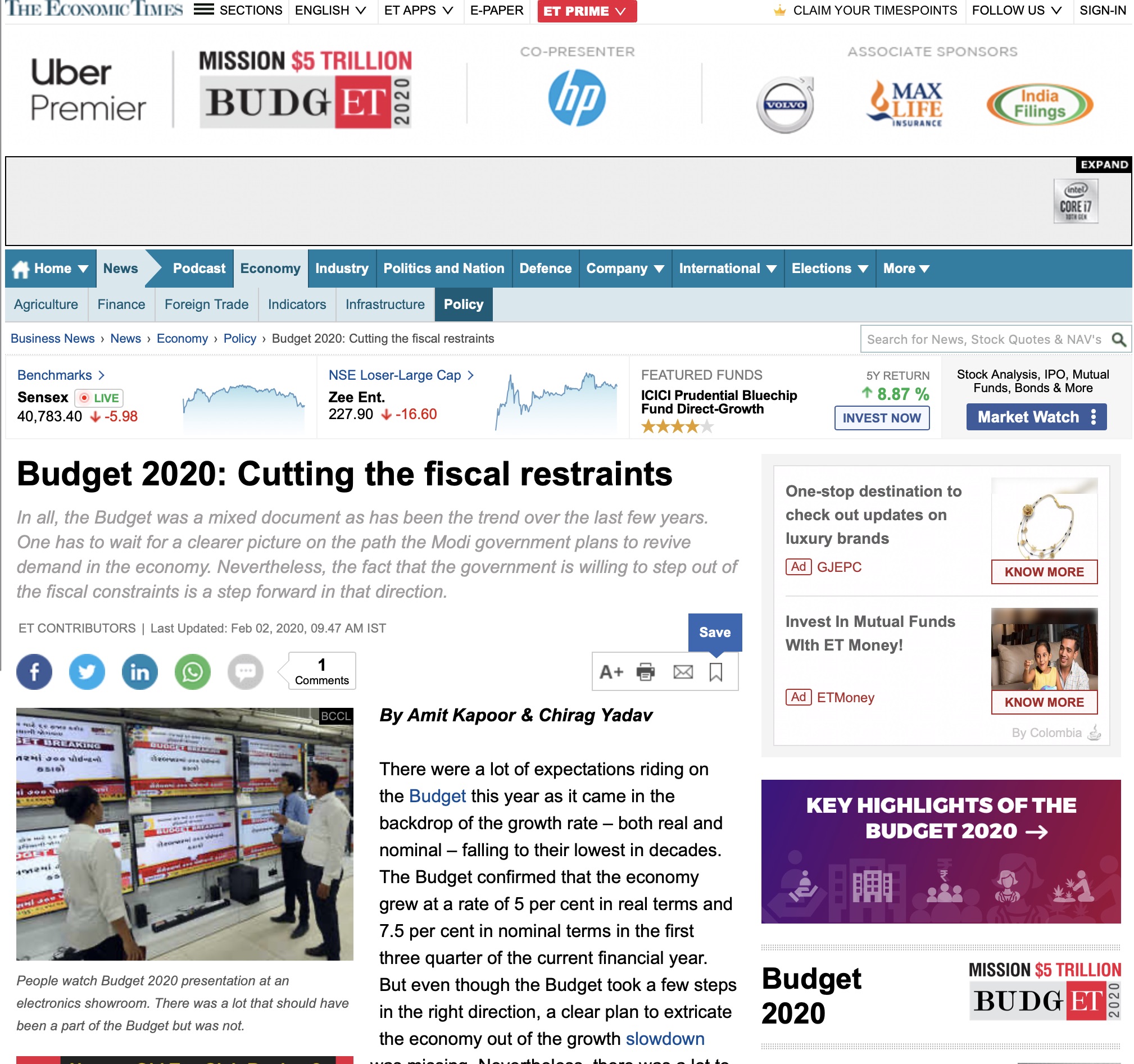Positively Leadership
Dean of the IE School of Human Sciences and Technology, Lee Newman suggests a new approach to leadership designed to achieve behavioral advantage—“an advantage achieved by building an organization of individuals and teams that think and perform better at all levels”. He argues that sustainable competitive advantage is no longer attainable in the conventional sense but that it is possible to obtain behavioral advantage.
Newman was shortlisted for the 2015 Thinker50 Breakthrough Idea Award. Des Dearlove talked to Lee Newman in Madrid. He started by talking about the disappearance of traditional notions of competitive advantage.
You talk about a new source of competitive advantage. Can you explain?
As I see it, the traditional types of competitive advantage are not really very sustainable anymore. A product or service advantage — say your company delivers products better than the competition — just doesn’t last, and even information advantages where your company gets better information faster than the competition also don’t last.
There’s a kind of new source of sustainable advantage for companies, a behavioral advantage. The idea is that if you imagine a company where employees literally are able to outthink and outbehave their competition time and time again that’s an incredible advantage. It’s hard to achieve, but it’s even harder to copy. Although leadership is often treated as a lofty concept reserved for the few, in my view it really comes down to concrete behaviors that happen moment by moment. Leadership plays out “in the moment” – in the daily conversations, meetings, presentations, negotiations, interpersonal conflicts, and thinking and problem-solving sessions that we engage in every day in the workplace.
So that’s the backdrop to positive leadership. Positive leadership is about how we can achieve this behavioral advantage, by improving performance in the moment.
What problem or challenge does positive leadership address?
The core problem it addresses is engagement. When you look at employee engagement numbers in global surveys, regardless of which one you look at, basically only about 20 to 30 percent of employees are fully engaged. Of course this is bad for the well-being of the employees and it’s equally bad for the bottom line of companies.
If you think about engagement, which is one of the core missions of any organizational leader or manager, in a sense the profession of leadership and management is failing. We’re failing as an institution. If doctors had a success rate of only 20 to 30 percent in curing basic ailments, we would be outraged.
I think the key question is what can managers and leaders do to turn the situation around and achieve a behavioral advantage? The answer is positive leadership.
Define positive leadership. You’ve given us a great context and logic for why we need it, but what is it?
Engagement and performance in the workplace is not an abstract thing. It’s something that happens moment by moment. To achieve high levels of engagement, to solve this problem that I just mentioned, to help employees to think better in the moment and create the conditions in which peak performance can happen, something has to change. The idea is to bring the findings of behavioral science and research to bear on helping people perform at their best and to help managers create an environment in which they can do so.
The way I define positive leadership is to say that it enables high engagement and performance in three ways. The first core element is what I call mindware training, and the idea is literally to rethink the way that we think in the workplace. Psychology and neuroscience have made great inroads in circumscribing a set of components that drive how we think, feel, and act. We can call these components “mindware”, and science has shown pretty clearly that there is a set of predictable defaults, biases, and errors that can produce behaviors that are far less productive and effective than they otherwise could be. Our attention wanders, we tend jump too quickly to conclusions about people and facts, and we take ownership of our early ideas and close ourselves to contradictory information and opinions.
If we can understand what those biases and unproductive shortcuts are, we can address them through simple “rethinks” that allow us to improve our performance with very little extra time. That’s the first element of positive leadership.
Can you give me an example of the first point?
Absolutely. One of the most pervasive and dangerous thinking biases is something that we talk about as narrow thinking and confirmation bias. Overall, this leads to incomplete thinking. What you see happen all the time is that people have an initial idea about how to approach the launch of a product or how to approach a situation in a meeting where there is a conflict, and what they tend to do is consider too few alternative courses of action and look for information that supports the idea they have in mind.
It turns out that that sends you down quite a slippery slope of thinking because it eliminates consideration of the kinds of things you might find that would actually go against what you are thinking. You also tend to act on that initial thought without scanning the environment and looking at more possibilities.
Thus, as managers and leaders we tend to ask one-sided questions and tend to reason in a way that gets us what we want from the very beginning. But we’re not aware that that’s what we are doing.
I work with executives and our Master’s students to teach them how to “flip” their thinking and how to be more mindful in the moment so that they can catch themselves committing these types of errors before it is too late.
Mindware and retraining how we think is the first component of positive leadership. What’s next?
The second part has to do with a positive environment. How can we build a positive environment in which people can perform at their best? Research shows very clearly that when the daily dose of positive relative to negative emotions that you experience is high, this has a profound impact on the quality of your behavior – how you think and behave…today. In the long term, if a person can maintain consistently high positivity ratios, it can boost important psychological resources such as resilience and even physical health. From a leadership standpoint, we can work to help employees reduce the impact of the negative emotions they experience every day, or even convert them to positive emotions and also change the environment so that on the whole it creates more positive emotional moments and fewer negative emotional moments.
That’s one piece of building a positive environment. Another has to do with changing the paradigm of development from being only about developing weaknesses to also being about helping people identify their strengths and use their strengths more in the workplace. When people use strengths to work on challenging tasks, it feels good — it creates positive emotions – and they become more engaged. In contrast, when people too frequently rely on weaknesses to meet workplace challenges, it drains them – it disengages them.
A third part of building a positive environment is also training managers to understand in concrete terms what exactly well-being is, how it is integrally linked to sustainable engagement and performance, and what kinds of things a manager can do to drive higher well-being in the workplace.
Creating a positive environment is the second part. What’s the third?
The third and critical piece to pull it together is a concept I have developed called behavioral fitness. A person may want to improve performance based on some behavioral change, for example, becoming a better listener, doing less micromanaging, being more open to ideas of colleagues, or changing the way she handles negative events. The motivation and intention to do those things is wonderful, but research shows that most of our attempts to change end in failure. We start but never finish. How do we increase the likelihood that we’re going to be successful in any kind of behavioral change? Behavioral fitness is a solution to this problem.
The way I think about it is that you don’t go to the gym for three days and come out physically fit. It’s the same thing with training behaviors. We need to shift the paradigm in terms of viewing our own professional development as an everyday process, not as an event. We need to think of the workplace in the same way we think about the gym.
A conflict-oriented meeting that you are going run tomorrow morning, the negotiations you are going to have with the client in the afternoon — these are the exercise stations of the workplace. If all you do is sit on a bench and stare at a barbell, nothing happens. The same thing applies to the workplace: if you don’t consider your meetings, conversations, and problem-solving sessions as opportunities to practice and improve your behaviors, no development happens. The idea is that you’ve got to practice the behaviors you want to improve. There is a rich and vast array of tools and techniques we can pull from the behavioral sciences to help us improve our odds of making behavioral changes happen in the workplace.
What would be an example of that? What sort of things can people actually do?
We can think of the current behaviors we would like to change in certain situations as habits. There’s a whole science of how habits work. We can bring those simple ideas to bear in helping people improve the odds of making change happen. There’s a nice framework that’s been put forward for thinking about habits as a kind of habit loop. For example, you want to become a better listener (and your coworkers want this as well). Your current behavior might be to frequently think that you know what others are saying and interrupt them before they have finished expressing their thoughts. What triggers this behavior? Perhaps it’s time pressure, perhaps overconfidence or ego; different things might trigger the behavior for different people. And why do you do it? There is some reward. Perhaps the behavior saves you time, or it strokes your ego, or gives you a sense of being smarter than others.
Thus, for any change we want to make, we have to identify what the current behavior is and then make a plan for what we want the new behavior to be. To drive the change, we sometimes may have to create triggers for the new behavior, and also create rewards that incentivize us to do it. By using habit science, we can literally rewire behaviors. It’s never easy, but with a structured process for doing it, the odds of success greatly increase.
Are you saying that understanding and even mapping our own behaviors is something many people haven’t traditionally done?
Yes, that’s exactly right. When you sign up for the gym, the trainer will ask you what you want to work on? Do you want to work on legs? Do you want to work on shoulders? Do you want to work on core muscle strength? You tell the trainer, and then the trainer designs a program for you. But the exercise program is just an idea. You’ve got to go to the gym and you’ve got to actually practice at the different stations and the different elements of your program; otherwise nothing happens.
What I’m proposing is basically the same thing for the workplace. If you have the intention of becoming a better listener, you need to identify the situations that happen daily at work in which you feel you are not a good listener, and you need a specific plan that you are going to put in place, so that when you find yourself in these moments, instead of the bad listening behavior coming out, the new and better form of listening comes out. Once you practice the new behavior, it eventually becomes your new habit, and you are a better listener. But motivation and intention to become a better listener on their own don’t get you there.
In this new model that you are advocating, who plays the role of the fitness coach or the personal trainer?
There are three parties involved. First, someone has to work with individuals to help them identify what behaviors to change and then give them tools for making those changes happen. That’s just the start. Then people need to practice in the workplace, and to practice there needs to be a safe and change-oriented, change-promoting environment. That’s the role of managers. I think that managers play a key role here in establishing a culture in their teams or their units, a modus operandi in which we are all changing, we are all constantly improving.
There’s the individual and manager training that has to happen, which I think can happen at business schools and in corporate training programs. Then there is a third role, a social element to this. If I’m in a safe environment and the people I’m working with know that I’m working on becoming a better listener, they can be active helpers in supporting the change process. Thus, socializing my change effort can provide a healthy and positive form of pressure and also supportive feedback.























